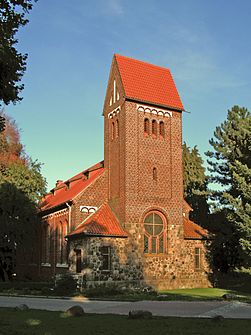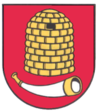Kästorf (Gifhorn)
|
Kaestorf
City of Gifhorn
|
|
|---|---|
| Coordinates: 52 ° 31 ′ 10 ″ N , 10 ° 32 ′ 18 ″ E | |
| Height : | 57 (54-65) m above sea level NHN |
| Area : | 14.1 km² |
| Residents : | 3100 (Nov. 9, 2017) |
| Population density : | 220 inhabitants / km² |
| Incorporation : | March 1, 1974 |
| Postal code : | 38518 |
| Area code : | 05371 |
|
Location of Kästorf in Gifhorn
|
|
|
Evangelical Lutheran Lazarus Church
|
|
Kästorf is the northernmost district of the Lower Saxon town of Gifhorn with around 3100 inhabitants. The place has the shape of a street village that stretches along the 2.6 km long main road.
geography
Geographical location
The area of the district Kästorf extends in the transition area between Harz and Heide in the north of Gamsen and south of Wagenhoff . The main road leading through the village corresponds to the former route of the B 4 .
Neighborhood to places and districts
The closest larger cities are Wolfsburg in the east, Braunschweig in the south and Celle in the north-west .
In a clockwise direction, Kästorf borders the field marks of the following localities: West Wilsche , northwest Ummern , north Wagenhoff and Wesendorf , east Neudorf-Platendorf and Gamsen , whose parts of the area surround it in all four directions.
history
The former municipality of Kästorf was incorporated on March 1, 1974 as part of the Lower Saxony regional reform .
politics
Local council
The local council of Kästorf consists of two councilors and five councilors, which is chaired by the local mayor . This body is to be heard on important matters affecting the locality. The final decision on a measure rests with the Gifhorn City Council .
Distribution of seats
- Independent list Gifhorn : 3 seats
- CDU : 2 seats
- SPD : 1 seat
- Greens : 1 seat
(Source:)
Local mayor
The local mayor is Jürgen Völke (Gifhorn Independent List). His deputy is Rita Wendig (CDU).
coat of arms
The design of the municipal coat of arms of Kästorf comes from the main state archive in Hanover and from the heraldist and coat of arms painter Gustav Völker , who designed all the coats of arms in the Hanover region . The coat of arms was approved by the local council on May 24, 1963 and approval was granted on July 4 of the same year by the Lüneburg government president.
| Blazon : "In red, a golden beehive floatingover a gold-studded silver horn ." | |
| Reasons for the coat of arms: The beehive shown symbolizes hard work. The Kästorf municipality borrowed the horn shown from the coat of arms of the Gifhorn district . |
economy
In the north of Kästorf there is the Diakonie Kästorf, an aid company that is active in the areas of care for the elderly, assistance for the disabled, youth assistance and assistance for the homeless.
Culture and sights
Buildings
- Evangelical Lutheran Church of Lazarus
Regular events
- A so-called “four villages meeting” was set up for the community care of the individual districts of Gifhorn
- A maypole is set up every year
- On the weekend before Ascension Day , the shooting festival takes place, which lasts three days
- In autumn the harvest festival takes place, which leads through the village with a parade with tractor and wagon
- A Christmas tree is set up in the village on the first of Advent
- The annual bicycle rally takes place on Ascension Day
- In January there is a fire brigade ball, which is decorated with new topics every year
Personalities
Sons and daughters of the place
- Olaf Prenzler (* 1958), track and field athlete (sprinter) and Olympic participant, 1982 European champion in the 200-meter run, won four other medals at the European Championships in 1978, 1982 and 1986
People connected to the place
- Otto Strecker (1851–1927), Lutheran clergyman and journalist, in 1890 he moved to the third pastorate in the city of Gifhorn, which included the Kästorf workers' colony in particular
- Franz Laufke (1901–1984), lawyer and university professor, he worked as a private scholar and night watchman in Kästorf
- Hermann Speckmann (* 1937), social worker, qualified pedagogue and non-fiction author, he worked in the Diakonische Heimen in Kästorf (1982-2000)
See also
literature
- Office for state planning and statistics (ed.): The districts in Lower Saxony . The district Gifhorn (= German counties, manual administrative, economic and cultural publications. D series . Band 26 ). Walter Dorn Verlag, Bremen-Horn 1972, ISBN 3-87172-327-4 ( limited preview in the Google book search).
- Wilhelm Warnecke: History of our village Kästorf . Ed .: City of Gifhorn. Self-published, Gifhorn 1987.
Web links
- Website with information on Kästorf
- Kästorf: 60 year old houses suddenly illegal? on June 30, 2020 on ndr.de
Individual evidence
- ^ Federal Statistical Office (ed.): Official municipality directory for the Federal Republic of Germany . Final results according to the September 13, 1950 census. Volume 33 . W. Kohlhammer Verlag, Stuttgart / Cologne August 1952, p. 43 , col. 1 ( digital version [PDF; 26.4 MB ; accessed on June 22, 2019] Landkreis Gifhorn, p. 52).
- ↑ a b Matthias Nerlich : Explanation for the development plan no. 15 “Silbereich Süd”, with local building regulations (ÖBV) . Ed .: City of Gifhorn. Gifhorn November 9, 2017, p. 6 ( digital copy [PDF; 863 kB ; accessed on September 28, 2018]).
- ↑ Delimitation of the localities and the urban area. (PDF; 3.1 MB) In: Website of the city of Gifhorn. City of Gifhorn / Urban Planning Department - Source of the Lower Saxony Surveying and Cadastre Administration, 2017, accessed on September 28, 2018 .
- ^ Federal Statistical Office (ed.): Historical municipality directory for the Federal Republic of Germany. Name, border and key number changes in municipalities, counties and administrative districts from May 27, 1970 to December 31, 1982 . W. Kohlhammer, Stuttgart / Mainz 1983, ISBN 3-17-003263-1 , p. 226 .
- ↑ a b Details of the “Local Council Kästorf” committee. In: Website of the council and citizen information system of the city of Gifhorn. Retrieved September 28, 2018 .
- ↑ District of Hanover (ed.): Wappenbuch district of Hanover . Self-published, Hanover 1985.
- ^ A b Arnold Rabbow: Braunschweigisches Wappenbuch . The coats of arms of the communities and districts in the urban and rural districts of Braunschweig, Gandersheim, Gifhorn, Goslar, Helmstedt, Peine, Salzgitter, Wolfenbüttel and Wolfsburg. Ed .: Braunschweiger Zeitung, Salzgitter Zeitung and Wolfsburger Nachrichten. Eckensberger & Co Verlag, Braunschweig 1977, DNB 780686667 , p. 33 .
- ^ Diakonie Kästorf Foundation. In: Website of the Diakonie umbrella foundation. Retrieved September 28, 2018 .
- ↑ Christina Rudert: Diakonische Homes: Church is now called Lazarus Church. In: Internet site Wolfsburger Allgemeine Zeitung . October 7, 2012, accessed September 28, 2018 .



